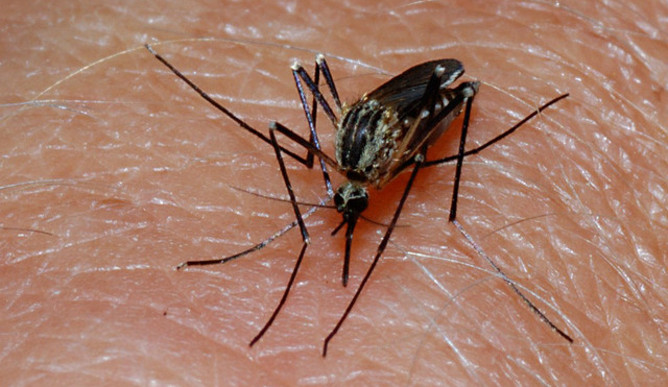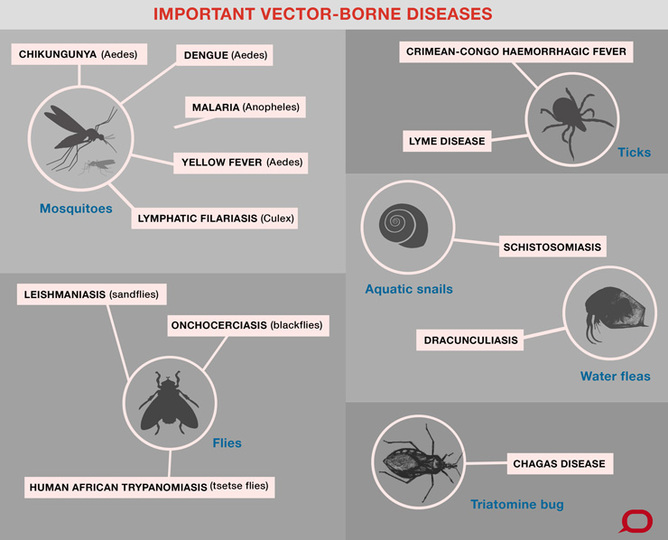Bites and Parasites: Vector-Borne Diseases and the Bugs Spreading Them


This article was originally published at The Conversation. The publication contributed the article to Live Science's Expert Voices: Op-Ed & Insights.
The term “vector-borne” refers to the way diseases are passed on from one person to another. Instead of through the air or directly by human contact, these pathogens need to hitch a ride for transmission. Vectors are any organisms that carry disease-causing pathogens from host to host.
Vector-borne diseases are responsible for 17 percent of all infectious diseases; they cause a staggering one billion deaths each year.
Mosquitoes, ticks and parasites
The most obvious vectors are mosquitoes. These “shared syringes of the natural world” can transmit diseases such as Ross River fever, malaria or dengue.
But menace doesn’t just lurk in the air; other nasties are involved as well.
Many people will have heard of Lyme disease being transmitted by ticks. Some ticks in Africa, the Middle East and the Caucasus can also transmit a virus that causes an often deadly haemorrhagic fever, known as the Crimean-Congo haemorrhagic fever.
In parts of Africa and some regions in Asia and South America, contact with water can mean infection with parasitic worms that cause the disease schistosomiasis. This chronic infection kills an estimated 200,000 people a year and has a great impact on affected economies.
Get the world’s most fascinating discoveries delivered straight to your inbox.
The vectors of Schistosoma worms are aquatic snails. When someone is infected with the worm, her stool will contain worm eggs. And when sewage comes into contact with freshwater, the eggs will develop into larvae and multiply inside snails, changing their form. The changed larvae are extremely infective to humans. They escape from the snails into the water and if you happen to wade through this particular pool, the larvae will attach and bore through your skin.
In the Americas, triatomine bugs carry the parasite causing Chagas disease. These “kissing bugs” live in crevices of the wall and roofs of houses. At night, they suck blood from sleeping humans, preferring the face (the “kiss” of the bug).
The parasites in the bug’s faeces are left on the skin when the bug defecates after a blood meal. Scratching of the bite during the next days allows the parasites to enter the wound.
Chronic Chagas disease can lead to life-threatening heart and digestive disorders. There is a theory that even Charles Darwin himself suffered from this unpleasant souvenir of his travels.
In terms of deadliness, there’s one vector-borne disease that stands out. Malaria causes an estimated 660,000 deaths every year; most of those killed are African children under five years of age. The economic impact of the disease is enormous.
Malaria parasites are especially known for their ability to become immune against drugs. Drug-resistant malaria strains are a major worry for global health.
Deadly but neglected
Many vector-borne diseases fall into the category of illnesses called neglected tropical diseases. They have a major impact on the lives of millions of people.
But since these people live in the usually poor, tropical regions of our planet, we don’t hear very much about it. Lack of awareness and a low market value also mean there’s only very little funding for research into those diseases.
And there’s another complication. With the changes in our climate, the distributions of vectors around the world are shifting.
A recent study on malaria in Ethiopia and Colombia showed malaria infections are moving to higher altitudes.
Disease-transmitting ticks in Europe are now found further north than previously. Lower winter temperatures lead to ticks being active during winter instead of lying dormant, waiting for spring.
At the same time, new vectors are appearing and spreading. Aedes albopictus, the vector for dengue and chikungunya, was accidentally imported to Italy in 1990. The larvae were hiding in tiny remnants of water inside old tyres. Those mosquitoes have now spread through most of the Mediterranean region and have been even found as far north as the Netherlands.
Milder winters allow this subtropical insect to remain in Europe. So far dengue and chikungunya are still rare there and are only linked to disease imported from other countries. But the risk of the mosquito spreading and getting established is high, and the situation is being carefully watched.
Other changes in the environment are also playing a role. Deforestation and loss of monkey habitat has been suggested as one of the reasons why infections with monkey malaria in Asia are now more common.
So what can be done?
Even though funding is poor, there is research into these diseases and some new drugs are being tested. Many not-for-profit initiatives such as the Bill & Melinda Gates Foundation, End7 and Medicines for Malaria Venture are seeking to raise awareness for diseases and to effectively link academic research with industry to develop the best drugs.
The most efficient way of combating vector-borne diseases is targeting their vectors. The United States managed to eradicate malaria 50 years ago by following through with widespread campaigns of mosquito eradication.
Disney’s seven dwarves help malaria eradication efforts.
Even Disney’s seven dwarfs helped out, though I wouldn’t recommend their approach of just adding oil to swamps today.
Insecticide-treated bed nets protect people during the night and are being distributed to even the poorest areas. And better sanitation in developing countries is important to help stop the spread of diseases.
If you are planning on travelling to the subtropical or tropical regions of this planet, make sure you take the available prophylaxis and vaccines against any diseases in that region. And while at home, be aware of mosquito-borne diseases and use mosquito repellent.
Simona John von Freyend does not work for, consult to, own shares in or receive funding from any company or organisation that would benefit from this article, and has no relevant affiliations.
This article was originally published on The Conversation. Read the original article. Follow all of the Expert Voices issues and debates — and become part of the discussion — on Facebook, Twitter and Google +. The views expressed are those of the author and do not necessarily reflect the views of the publisher. This version of the article was originally published on Live Science.



